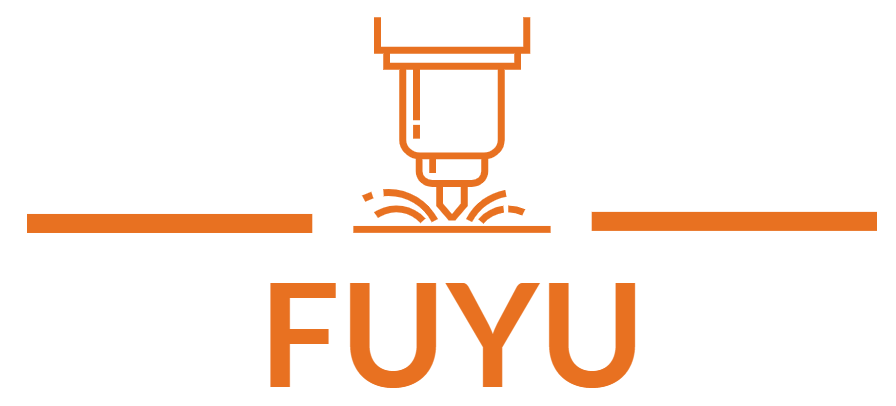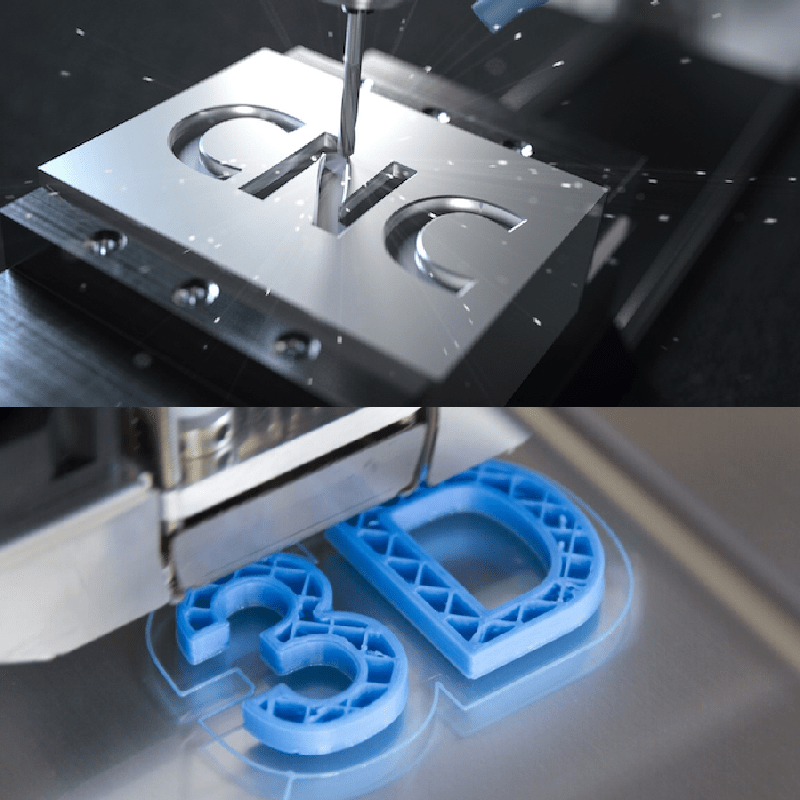CNC Machining vs. 3D Printing
When it comes to selecting the right technology for manufacturing custom parts, two standout contenders often come to mind: CNC machining vs. 3D printing. Each brings a unique set of strengths to the table, from the perfection in subtractive processes of CNC machining to the revolutionary additive layers of 3D printing. This guide delves into the practical differences between the two, offering essential insights for manufacturing prototypes, end-use parts, and everything in between.
CNC Machining vs. 3D Printing: Difference
CNC machining, a hallmark of subtractive manufacturing, excels at transforming a raw material block into nearly finished components with a diverse array of tools. Its reputation for high accuracy, excellent repeatability, and an extensive material palette has established CNC as a preferred method for both bespoke tasks and larger production runs.

Conversely, 3D printing, an additive manufacturing marvel, constructs parts layer by layer, requiring minimal initial setup and thus, significantly lowering costs. This technology shines in producing complex geometries swiftly and cost-effectively, marking its territory in prototyping and functional part production alongside CNC machining.

Selecting Your Manufacturing Champion
Which technology triumphs for your specific project? While CNC machining commands the arena of precision and mechanical properties, endorsing its use for parts easily crafted through subtractive means, 3D printing emerges victorious under a different set of conditions:
1. Complex Designs: Unattainable through traditional means or requiring prohibitive costs for CNC machining.
2. Rapid Turnaround: 3D printing boasts remarkably quick delivery times, sometimes within a day.
3. Budget Constraints: Smaller volumes or prototypes benefit from 3D printing’s cost-efficiency.
4. Material Constraints: If your design mandates materials challenging to machine, 3D printing extends a versatile palette including metal superalloys and TPU.
Traditional forming technologies like injection molding might still hold the crown for mass-producing parts at scale, steering you away from 3D printing or CNC machining for large orders.
| No. of Parts | Plastic | Metal |
|---|---|---|
| 1-10 | 3D printing | CNC machining (consider 3D printing) |
| 10-100 | 3D printing and CNC machining | CNC machining |
| 100-1000 | CNC machining (consider Injection molding) | CNC machining (consider Investment casting) |
| 1000+ | Injection molding | Investment or Die casting |
Material Matters: Machining Metals vs. Printing Plastics
Both CNC machining and 3D printing accommodate a broad spectrum of materials. CNC machining predominantly produces metal parts but can also handle plastics, acrylics, and even certain woods. 3D printing, a plastic maestro, has recently branched out into metals, ceramics, and even bio-materials, though it may offer a slightly lesser degree of mechanical properties due to its anisotropic nature.
What are the most common CNC materials?
Great mechanical and thermal properties with fully isotropic behavior
Dimensional restrictions from blank size (using a non-standard blank size will increase the manufacturing cost)
Plastics: ABS, Nylon, Polycarbonate, PEEK
Metals: Aluminum, stainless steel, titanium, brass
What are the common 3D printing materials?
Wide variety of materials with a wide range of physical properties
Materials that are difficult to machine (TPU and metal superalloys) can be 3D printed
Potentially lesser mechanical properties compared to CNC parts, as they are typically not fully isotropic
Plastics: Nylon, PLA, ABS, ULTEM, ASA, TPU
Metals: Aluminum, stainless steel, titanium, Inconel
Mastering Complexity in Parts Manufacturing
Crafting intricate components is a critical aspect to weigh when deliberating between 3D printing and CNC machining, each with its design constraints. CNC machining can be restrictive in the range of possible shapes, bounded by limitations such as tool reach, required clearances, and fixture points, and hindered by an inability to create perfectly square corners due to the shape of the tools. Some designs might be entirely unattainable with CNC because of inaccessible part areas—even with advanced 5-axis machines.
Operators often need to rotate the workpiece for tool access to various angles, increasing time and labor costs. The necessity for additional jigs and fixtures can further inflate the cost of the finished product.
In contrast, 3D printing offers substantial design flexibility with minimal geometrical limitations. While processes like Fused Deposition Modelling (FDM) may necessitate support structures, this minor increase in post-processing doesn’t undercut the otherwise extensive creative freedom this technology offers.
Particularly, methods like Selective Laser Sintering (SLS) and Multi Jet Fusion (MJF) are lauded for their ability to effortlessly craft free-flowing, organic shapes without supporting scaffoldings, highlighting the inherent advantage of 3D printing in fabricating highly complex designs with ease.
Does 3D printing or CNC machining offer better dimensional accuracy?
CNC machining stands out for its remarkable ability to achieve high precision and consistent results across a wide range of part sizes. From substantial components down to the minutest details, CNC can maintain exact tolerances. The design of the cutting tools, however, means that internal corners will exhibit a radius, although it’s possible to achieve sharp edges and extremely thin features on external surfaces.
On the other hand, the dimensional accuracy of 3D printing varies significantly across different systems. Industrial-grade 3D printers are capable of producing parts with commendable precision. For instances demanding stringent tolerances, parts can initially be printed with slightly larger dimensions and then refined through post-processing machining.
The minimum thickness achievable in 3D printed components is determined by the specifics of the printing mechanism, such as the nozzle diameter in Fused Deposition Modeling (FDM) or the laser spot size in Selective Laser Sintering (SLS). The layer-by-layer construction process may result in visible layer lines, particularly noticeable on curved areas. Additionally, the maximum size of 3D printed parts is generally limited, partly because the printing process often necessitates careful control over environmental conditions.
| Technology | Tolerance | Minimum wall thickness | Maximum part size |
|---|---|---|---|
| CNC machining | ± 0.025 – 0.125 mm* | 0.75 mm | Milling: 2000 x 800 x 1000 mm Lathe: Ø 500 mm |
| SLS | ± 0.300 mm | 0.7 – 1.0 mm | 300 x 300 x 300 mm |
| FDM | Desktop: ± 0.500 mm Industrial: ± 0.200 mm | 0.8 – 1.0 mm | Desktop: 200 x 200 x 200 mm Industrial: 900 x 600 x 900 mm |
| SLM/DMLS | ± 0.100 mm | 0.40 mm | 230 x 150 x 150 mm |
| Binder jetting | ± 0.200 mm | 2.0 mm | 380 x 355 x 735 mm |
Conclusion
As the landscape of manufacturing technologies continues to evolve, understanding the nuances between CNC machining and 3D printing will empower you to choose the right path for your custom part needs, ensuring efficiency, quality, and innovation in every project.
FAQs – CNC Machining vs. 3D Printing
Q1: Is CNC machining superior to 3D printing?
A1: It hinges on your project’s specifics. CNC offers smoother finishes and fits, while 3D printing is the go-to for rapid prototyping and complex geometries.
Q2: What’s the optimal 3D printing technique for plastic parts?
A2: For prototyping and functional parts, FDM and SLS are the top recommendations.
Q3: Which 3D printing method is best for metal parts?
A3: SLM/DMLS and Binder Jetting stand out for creating functional metal parts and prototypes.
Q4: Can 3D printing make CNC machining obsolete?
A4: While 3D printing is expanding its material capabilities, CNC machining remains indispensable for numerous applications due to its precision and material versatility.
Q5: What should I consider when choosing between 3D printing and CNC machining?
A5: Reflect on your part’s complexity, required precision, material, production volume, and budget constraints to guide your decision.
Learn more about our Plastic CNC Machining capability, visit website: https://fuyutechnology.com/plastic-cnc-machining/


